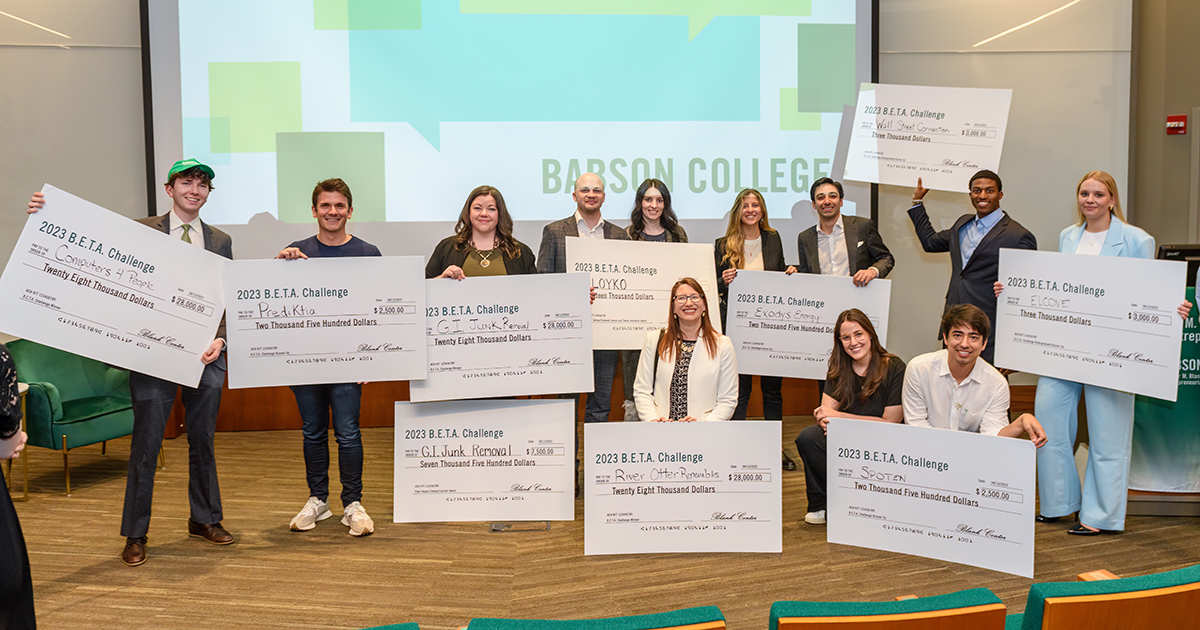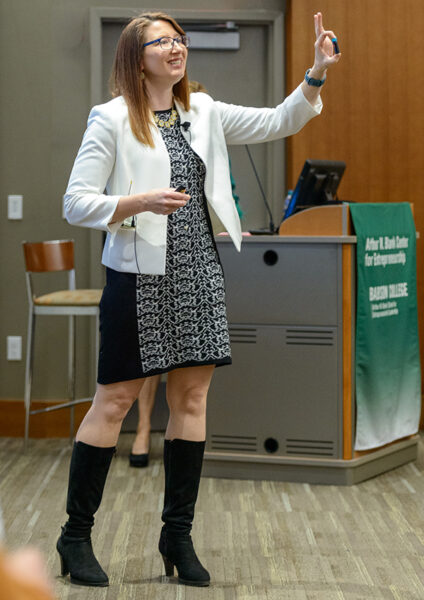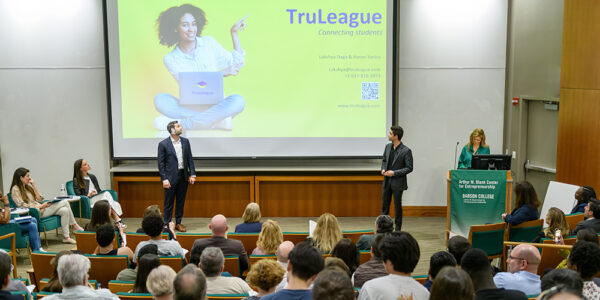5 Successful Strategies from B.E.T.A. Challenge Finalists

Stepping into the world of the B.E.T.A. (Babson Entrepreneurial Thought & Action®) Challenge is like entering the entrepreneurial Olympics where contestants vie for a $25,000 grand prize.
The annual competition hosted by The Arthur M. Blank Center for Entrepreneurship is more than just a business competition—it’s an immersive experience for both contestants and the audience. It is where innovative ideas take the spotlight, competitors thrive in a supportive entrepreneurial landscape, and success is celebrated collectively. This year, the B.E.T.A. Challenge finale will be held at 5 p.m. Thursday, April 11 in Winn Auditorium.
Register today to attend the 2024 B.E.T.A. Challenge Finale on April 11.
As competitors gear up for the upcoming culmination event, we’ve tapped into the wisdom of previous finalists who have succeeded in the B.E.T.A. Challenge to share their advice to navigate the twists and turns of the adventure.
Tell an Authentic Story
The B.E.T.A. Challenge requires more than a conventional pitch. It involves authentically sharing your story and realizing that you are the expert in your business.
“Shifting our mindset from delivering a perfect pitch to sharing our authentic story with the audience was very helpful.” — Lakshya Daga MBA’23, TruLeague, graduate student track finalist in 2023
Practice Your Pitch

“(The) B.E.T.A. (Challenge) was my first time ever pitching, and at the time, I really did not like public speaking. However, I reminded myself that I get the opportunity to talk about my business and spread our mission.” — Anastacia Yefimenko ’25, Elcove, undergraduate student track finalist in 2023
From refining pitches to crafting concise, impactful answers, the road to success involves strategic preparation and leveraging available resources.
“Professor Sebastian Fixson was absolutely amazing at helping me prepare. He pointed out general gaps in my pitch and had essential advice for answering questions. Answer a question with a sentence or two, and then stop talking. If the person wants additional information, they will ask a follow-up question. If they ask the follow up question, you have a measure of how interested they are and if they understood your answer.” — Amelia Thomas MBA’22, River Otter Renewables, alumni track winner in 2023
“Preparing for the judges’ Q&A was a collaborative effort. We brainstormed extensively within the team, anticipating a variety of questions and crafting concise yet impactful answers. Providing evidence-driven responses is key and during our preparations, we made sure to collect data from reliable sources to back up answers. Practicing under time constraints helped us refine the delivery of responses.” — Daga
“When pitching, it’s important you can get your business idea across in a clear and concise way, while also being engaging. I went to the Speech Center multiple times to help me craft my pitch and pitch deck. To prepare for the Q&A, I started practicing my pitch to my friends, family, and mentors. I had asked them to come up with questions they had or thought could be asked. From there, I created supplementary slides that could help me answer questions.” — Yefimenko
Know You’re Not Alone
Overcome fear and nerves by recognizing that this isn’t a solo endeavor.
“For the one-minute (semifinals) pitch, I was so scared. But the judges were incredibly friendly, and my classmates and competitors were supportive. I relaxed significantly for the finals because I remembered that the audience were my friends and professors. What also helped me most was remembering that (The) B.E.T.A. (Challenge) is a low-risk/high-reward situation. No one will laugh if I screw up or get flustered. Everyone will fumble a little, myself included, and the important part will be how I recover from whatever my fumble will be.” — Thomas
Show Progress
Showcase your progress and how you have leveraged feedback to demonstrate potential for real impact.
“The most important thing that the B.E.T.A. Challenge looks for is traction. Judges want to know if this has the potential to become a real business and if you’re progressing on your work at a fast pace. Make sure that your pitch shows your most recent progress and what happened since the last time they read about your startup.” — Aakash Shah MBA’21, High Time Foods, graduate student winner in 2021
“Feedback from the semifinals was invaluable in elevating our pitch for the finale. Each question posed by the judges served as a road map for further refinement, prompting us to explore new research avenues and incorporate fresh insights into the pitch.” — Daga

Just Do It

The B.E.T.A. Challenge is a unique opportunity to launch a venture forward, regardless of the outcome. So, don’t miss it.
“(The) B.E.T.A. Challenge launched River Otter. We instantly had access to partners, funding opportunities, and name recognition.” — Thomas
“Participating in the B.E.T.A. Challenge was one of the best experiences I’ve had at Babson. Aside from being able to use the funding to grow my business, (The) B.E.T.A. (Challenge) provided me with the confidence and resources to apply to more pitch competitions.” — Yefimenko
“High Time Foods exists because of the B.E.T.A. Challenge. If I hadn’t received all the encouragement I received from my classmates, Babson faculty, and the judges through the different stages of the competition, I might not have had the motivation to pursue the High Time Foods full time. The prize money I received from winning the B.E.T.A. Challenge was the first investment that was made to us, which enabled us to develop our product and launch it.” — Shah
Posted in Community, Entrepreneurial Leadership





